+ Open data
Open data
- Basic information
Basic information
| Entry | Database: PDB / ID: 6dmr | |||||||||
|---|---|---|---|---|---|---|---|---|---|---|
| Title | Lipid-bound full-length rbTRPV5 | |||||||||
 Components Components | Transient receptor potential cation channel subfamily V member 5 | |||||||||
 Keywords Keywords | TRANSPORT PROTEIN / TRPV5 / calcium channel / lipid-bound / full-length | |||||||||
| Function / homology |  Function and homology information Function and homology informationregulation of urine volume / calcium ion import across plasma membrane / calcium ion homeostasis / calcium ion transmembrane transport / calcium channel activity / calcium ion transport / protein homotetramerization / calmodulin binding / apical plasma membrane / metal ion binding ...regulation of urine volume / calcium ion import across plasma membrane / calcium ion homeostasis / calcium ion transmembrane transport / calcium channel activity / calcium ion transport / protein homotetramerization / calmodulin binding / apical plasma membrane / metal ion binding / identical protein binding / plasma membrane Similarity search - Function | |||||||||
| Biological species |  | |||||||||
| Method | ELECTRON MICROSCOPY / single particle reconstruction / cryo EM / Resolution: 3.9 Å | |||||||||
 Authors Authors | Hughes, T.E.T. / Pumroy, R.A. / Moiseenkova-Bell, V.Y. | |||||||||
| Funding support |  United States, 2items United States, 2items
| |||||||||
 Citation Citation |  Journal: Nat Commun / Year: 2018 Journal: Nat Commun / Year: 2018Title: Structural insights on TRPV5 gating by endogenous modulators. Authors: Taylor E T Hughes / Ruth A Pumroy / Aysenur Torun Yazici / Marina A Kasimova / Edwin C Fluck / Kevin W Huynh / Amrita Samanta / Sudheer K Molugu / Z Hong Zhou / Vincenzo Carnevale / Tibor ...Authors: Taylor E T Hughes / Ruth A Pumroy / Aysenur Torun Yazici / Marina A Kasimova / Edwin C Fluck / Kevin W Huynh / Amrita Samanta / Sudheer K Molugu / Z Hong Zhou / Vincenzo Carnevale / Tibor Rohacs / Vera Y Moiseenkova-Bell /  Abstract: TRPV5 is a transient receptor potential channel involved in calcium reabsorption. Here we investigate the interaction of two endogenous modulators with TRPV5. Both phosphatidylinositol 4,5- ...TRPV5 is a transient receptor potential channel involved in calcium reabsorption. Here we investigate the interaction of two endogenous modulators with TRPV5. Both phosphatidylinositol 4,5-bisphosphate (PI(4,5)P) and calmodulin (CaM) have been shown to directly bind to TRPV5 and activate or inactivate the channel, respectively. Using cryo-electron microscopy (cryo-EM), we determined TRPV5 structures in the presence of dioctanoyl PI(4,5)P and CaM. The PI(4,5)P structure reveals a binding site between the N-linker, S4-S5 linker and S6 helix of TRPV5. These interactions with PI(4,5)P induce conformational rearrangements in the lower gate, opening the channel. The CaM structure reveals two TRPV5 C-terminal peptides anchoring a single CaM molecule and that calcium inhibition is mediated through a cation-π interaction between Lys116 on the C-lobe of calcium-activated CaM and Trp583 at the intracellular gate of TRPV5. Overall, this investigation provides insight into the endogenous modulation of TRPV5, which has the potential to guide drug discovery. | |||||||||
| History |
|
- Structure visualization
Structure visualization
| Movie |
 Movie viewer Movie viewer |
|---|---|
| Structure viewer | Molecule:  Molmil Molmil Jmol/JSmol Jmol/JSmol |
- Downloads & links
Downloads & links
- Download
Download
| PDBx/mmCIF format |  6dmr.cif.gz 6dmr.cif.gz | 421.7 KB | Display |  PDBx/mmCIF format PDBx/mmCIF format |
|---|---|---|---|---|
| PDB format |  pdb6dmr.ent.gz pdb6dmr.ent.gz | 348.7 KB | Display |  PDB format PDB format |
| PDBx/mmJSON format |  6dmr.json.gz 6dmr.json.gz | Tree view |  PDBx/mmJSON format PDBx/mmJSON format | |
| Others |  Other downloads Other downloads |
-Validation report
| Summary document |  6dmr_validation.pdf.gz 6dmr_validation.pdf.gz | 977.8 KB | Display |  wwPDB validaton report wwPDB validaton report |
|---|---|---|---|---|
| Full document |  6dmr_full_validation.pdf.gz 6dmr_full_validation.pdf.gz | 988.4 KB | Display | |
| Data in XML |  6dmr_validation.xml.gz 6dmr_validation.xml.gz | 64.5 KB | Display | |
| Data in CIF |  6dmr_validation.cif.gz 6dmr_validation.cif.gz | 98.7 KB | Display | |
| Arichive directory |  https://data.pdbj.org/pub/pdb/validation_reports/dm/6dmr https://data.pdbj.org/pub/pdb/validation_reports/dm/6dmr ftp://data.pdbj.org/pub/pdb/validation_reports/dm/6dmr ftp://data.pdbj.org/pub/pdb/validation_reports/dm/6dmr | HTTPS FTP |
-Related structure data
| Related structure data |  7965MC  7966C  7967C  6dmuC  6dmwC M: map data used to model this data C: citing same article ( |
|---|---|
| Similar structure data |
- Links
Links
- Assembly
Assembly
| Deposited unit | 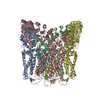
|
|---|---|
| 1 |
|
- Components
Components
| #1: Protein | Mass: 82899.656 Da / Num. of mol.: 4 Source method: isolated from a genetically manipulated source Source: (gene. exp.)   |
|---|
-Experimental details
-Experiment
| Experiment | Method: ELECTRON MICROSCOPY |
|---|---|
| EM experiment | Aggregation state: PARTICLE / 3D reconstruction method: single particle reconstruction |
- Sample preparation
Sample preparation
| Component | Name: lipid-bound TRPV5 / Type: COMPLEX / Entity ID: all / Source: RECOMBINANT |
|---|---|
| Source (natural) | Organism:  |
| Source (recombinant) | Organism:  |
| Buffer solution | pH: 8 |
| Specimen | Embedding applied: NO / Shadowing applied: NO / Staining applied: NO / Vitrification applied: YES |
| Specimen support | Details: unspecified |
| Vitrification | Cryogen name: ETHANE |
- Electron microscopy imaging
Electron microscopy imaging
| Experimental equipment |  Model: Titan Krios / Image courtesy: FEI Company |
|---|---|
| Microscopy | Model: FEI TITAN KRIOS |
| Electron gun | Electron source:  FIELD EMISSION GUN / Accelerating voltage: 300 kV / Illumination mode: FLOOD BEAM FIELD EMISSION GUN / Accelerating voltage: 300 kV / Illumination mode: FLOOD BEAM |
| Electron lens | Mode: BRIGHT FIELD |
| Image recording | Electron dose: 2 e/Å2 / Film or detector model: GATAN K2 SUMMIT (4k x 4k) |
- Processing
Processing
| EM software |
| |||||||||||||||||||||
|---|---|---|---|---|---|---|---|---|---|---|---|---|---|---|---|---|---|---|---|---|---|---|
| CTF correction | Type: PHASE FLIPPING AND AMPLITUDE CORRECTION | |||||||||||||||||||||
| Symmetry | Point symmetry: C4 (4 fold cyclic) | |||||||||||||||||||||
| 3D reconstruction | Resolution: 3.9 Å / Resolution method: FSC 0.143 CUT-OFF / Num. of particles: 29638 / Symmetry type: POINT |
 Movie
Movie Controller
Controller



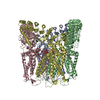
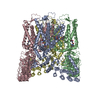
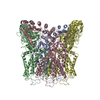
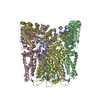



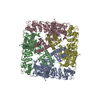
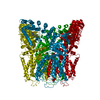

 PDBj
PDBj

